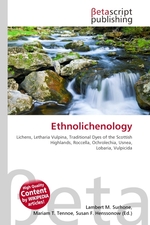Ethnolichenology
Lambert M. Surhone, Miriam T. Timpledon, Susan F. Marseken
бумажная книга
High Quality Content by WIKIPEDIA articles! High Quality Content by WIKIPEDIA articles! Ethnolichenology is the study of the relationship between lichens and people. Lichens have and are being used for many different purposes by human cultures on every continent, with the possible exception of Australia. The most common human use of lichens is for dye, but they are also frequently used for medicine and food. Different human cultures across the world have also found many other more novel uses for lichens. Lichens are a common source of natural dyes. The lichen dye is usually extracted by either boiling water or ammonia fermentation. Although usually called ammonia fermentation, this method is not actually a fermentation and involves letting the lichen steep in ammonia (traditionally urine) for at least two to three weeks. In North America the most significant lichen dye is Letharia vulpina. Indigenous people through most of this lichen's range in North America traditionally make a yellow dye from this lichen by boiling it in water.
Данное издание не является оригинальным. Книга печатается по технологии принт-он-деманд после получения заказа.


